| New York
Architecture Images- notes |
|
30 under 30 The Watch List of Future Landmarks |
| The 30 most significant
buildings under 30 years old (the age needed for landmark status in New
York). |
| |
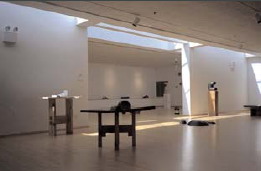 |
1.
Isamu Noguchi Garden
Museum
Isamu Noguchi and
Shoji Sadao
1985
32-37 Vernon Boulevard
Queens
www.philip.greenspun.com |
 |
2.
New York Public Library
South Court
Davis Brody Bond LLP
2002
Fifth Avenue at 42nd Street
© Peter Aaron/ESTO |
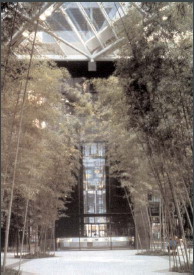 |
3.
IBM Building
Edward Larrabee Barnes
Associates
1983
590 Madison Avenue |
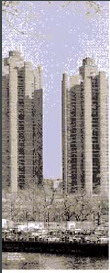 |
4.
Tracey Towers
Paul Rudolph with
Jerald L. Karlan
1974
20, 40 West Mosholu
Parkway
Bronx |
 |
5.
LVMH Tower
Christian de Portzamparc
& Hillier Architecture
1999
19 East 57th Street |
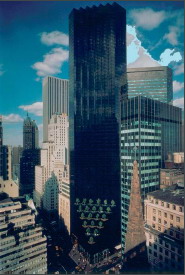 |
6.
Trump Tower
Der Scutt with Swanke
Hayden Connell Architects
1983
725 Fifth Avenue
|
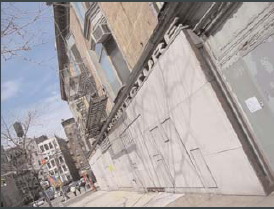 |
7.
Storefront for Art and
Architecture
Steven Holl
1993
97 Kenmare Street |
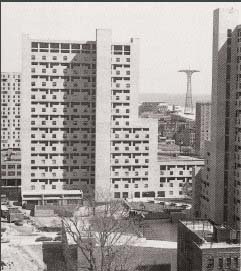 |
8.
Sea Park East Apartments
Hoberman & Wasserman
1975
Surf Avenue at
West 27th Street
Brooklyn
|
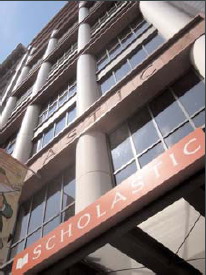 |
9.
Scholastic Building
Aldo Rossi with Gensler
2001
557 Broadway |
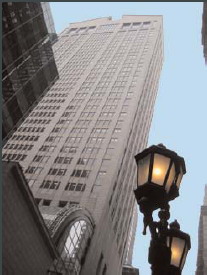 |
10.
AT&T/Sony Building
Philip Johnson/John Burgee
1984
550 Madison Avenue
|
 |
11.
The New 42nd Street
Studios
Platt Byard Dovell
Architects
2000
229 West 42nd Street |
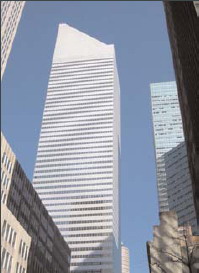 |
12.
Citicorp Center
Hugh Stubbins &
Associates/Emery Roth &
Sons
1977
153 East 53rd Street
|
 |
13.
Woodhull Medical and
Mental Health Center
Kallmann McKinnell & Wood
Architects, Inc.
1977
760 Broadway at
Flushing Avenue
Brooklyn |
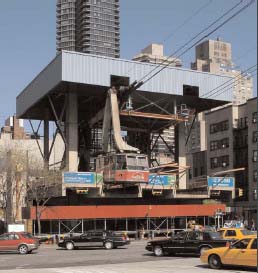 |
14.
Roosevelt Island
Tram Station
Prentice & Chan, Ohlhausen
1976
Second Avenue at
59th Street
|
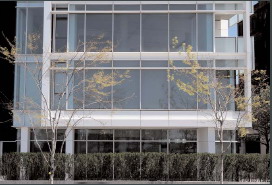 |
15.
173/176 Perry Street
Condominium Towers
(detail)
Richard Meier
2002
173/176 Perry Street |
 |
16.
Taino Towers
Silverman & Cika
1972-1979
221 East 122nd Street
|
 |
17.
Alfred Lerner Hall
Bernard Tschumi/
Gruzen Samton
1999
2920 Broadway |
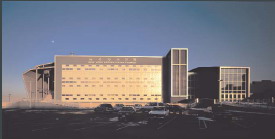 |
18.
Korean Presbyterian
Church of New York
Greg Lynn FORM,
Garofalo Architects and
Michael McInturf Architects
1999
43-05 37th Avenue
Queens |
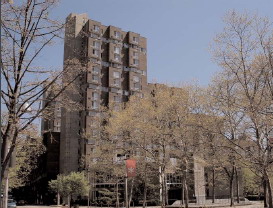 |
19.
Eastwood
Sert, Jackson & Associates
1976
510-580 Main Street
Roosevelt Island |
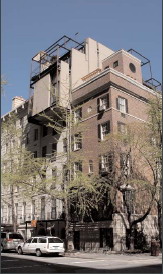 |
20.
Paul Rudolph Penthouse
Paul Rudolph
1977-83
23 Beekman Place
|
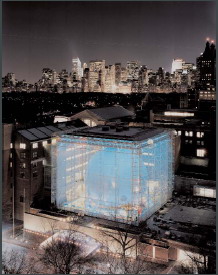 |
21.
AMNH Rose Center for
Earth and Space
Polshek Partnership
Architects
2000
Central Park West at
81st Street |
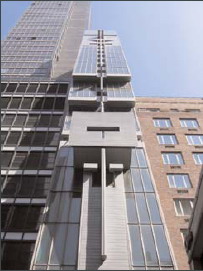 |
22.
Austrian Cultural Forum
Raimund Abraham
2002
11 East 52nd Street
|
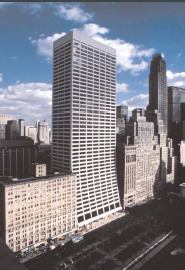 |
23.
Grace Building
and 9 West 57th Street
Skidmore, Owings &
Merrill LLP
1974
1114 Sixth Avenue |
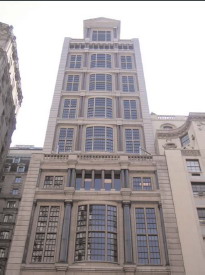 |
24.
Takashimaya
John Burgee Architects
1993
693 Fifth Avenue
|
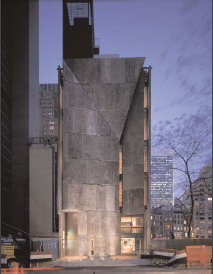 |
25.
American Folk Art Museum
Tod Williams Billie Tsien
Architects LLP
2001
45 West 53rd Street |
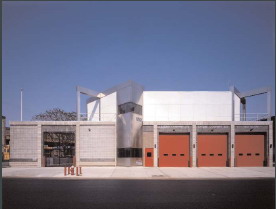 |
26.
Firehouse for Engine Co.
233 & Ladder Co. 176
Eisenman Robertson
Architects
1985
25 Rockaway Avenue
Brooklyn
|
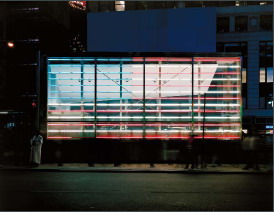 |
27.
U.S. Armed Forces
Recruiting Station
Architecture Research
Office LLP (ARO)
1999
Times Square |
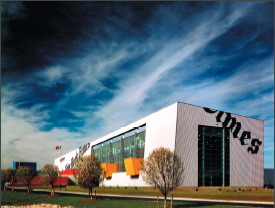 |
28.
New York Times Printing
Plant
Polshek Partnership
Architects
1997
26-50 Whitestone
Expressway
Queens
|
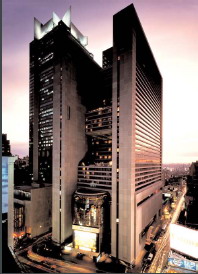 |
29.
New York Marriott Marquis
Hotel
John C. Portman, Jr.
1981-1985
1531-1549 Broadway |
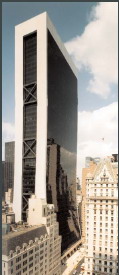 |
30.
9 West 57th Street
and Grace Building
Skidmore, Owings & Merrill
LLP
1974
9 West 57th Street
|
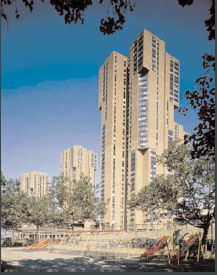 |
31.
Waterside Plaza
Davis Brody & Associates
1974
FDR Drive at 25th Street |
30 Under 30: The
Watch List of Future Landmarks
When, many years from now, we look back at the close of the 20th century,
which buildings will we select to tell our story?
An independent jury appointed by the Municipal Art Society of New York has
just released a list of 30 contemporary buildings that it believes to be
potential future landmarks. 30 Under 30: The Watch List of Future Landmarks
includes residential, cultural, religious and industrial buildings
constructed between 1974 and 2004 (photos). The list begins chronologically
with Skidmore, Owings & Merrill's Grace Building and its sibling 9 West 57th
Street, completed in 1974; and ends with Richard Meier's 173/176 Perry
Street Condominium Towers, completed in 2002. Spearheaded by the Society's
Kress Fellow for Historic Preservation, Vicki Weiner, work on the Watch List
of Future Landmarks began shortly after Mr. Meier's 1977 Bronx Developmental
Center disappeared under a radical alteration in 2002. Despite an
international reputation as a late Modern masterpiece, the building was not
yet 30 years old and therefore ineligible for landmark status and
protection. The loss of the building served as a wake-up call for the
Society to monitor -- watch -- these buildings today so they will survive
long enough to help tell the story of the late 20th century.
Over 150 buildings were nominated to the Watch List by design
professionals and the public. The jury used a set of established criteria to
judge the buildings based on their artistic, technological, historical and
canonic merits, and weighed the influence they had on design and culture in
the city and worldwide. Sherida Paulsen, an architect who was chairman of
the Landmarks Preservation Commission from 2001 to 2003, chaired the jury,
which included: Paola Antonelli, a curator at the Department of Architecture
and Design, MoMA; New York magazine architecture critic Joseph Giovannini;
interior designer Kitty Hawks; Paul Makovsky, senior editor of Metropolis
Magazine; architect Greg Pasquarelli of the firm SHoP; architectural
historian Nina Rappaport; David Sokol, managing editor of I.D. Magazine; and
Jacob Tilove, architectural historian at Robert A.M. Stern Architects.
http://www.mas.org/ContentLibrary/30Under30.pdf
http://www.mas.org/ContentLibrary/30Under30photos.pdf
|
| THE MUNICIPAL ART SOCIETY I
457 MADISON AVENUE I NEW YORK, NY 10022 I (212) 935-3960 I
WWW.MAS.ORG
In Preservation Wars, a Focus on
Midcentury
By ROBIN POGREBIN
Published: March 24, 2005
Arguing that significant buildings are not getting their due, advocates of
midcentury architecture are stepping up pressure on the city's Landmarks
Preservation Commission to hold full public hearings on proposals to
raze two movie theaters on the Upper East Side of Manhattan.
Plans have been announced to convert Cinemas 1, 2 & 3, a 1962
International-style theater on Third Avenue across from Bloomingdale's,
into retail space. The Beekman, a 1952 late Streamline Moderne design at
Second Avenue and 66th Street, is to be replaced by a breast and
diagnostic imaging center run by Memorial Sloan-Kettering Cancer Center.
The theater is scheduled to be closed down this summer.
On another front, a lawsuit was filed against the city last week in New
York State Supreme Court seeking to prevent reconstruction of 2 Columbus
Circle into the Museum of Arts and Design. The marble-clad building with
a "lollipop"-motif facade by Edward Durell Stone once housed Huntington
Hartford's Gallery of Modern Art. The landmarks commission has never
held a public hearing on the future of the building, on which demolition
is expected to begin in late May.
These two different battlefronts represent a larger argument on the part
of preservationists that the commission has generally neglected postwar
architecture and been unresponsive to their concerns about Modernist
sites.
"The commission ought to hear the arguments and let them be debated in a
public forum - that's democracy," the architect Robert A. M. Stern, who
is active in preservation issues, said in an interview.
But Holly Hotchner, director of the museum going into 2 Columbus Circle,
said, "There are no landmarks hearings on many buildings."
Friends of the Upper East Side Historic Districts, a group that is
spearheading opposition to the alteration of the movie theaters, said in
a statement: "These insensitive and destructive actions highlight the
urgent need to protect the Modern architecture on the Upper East Side
and across the city. The Landmarks Preservation Commission has
designated some important Modern buildings, but most remain at risk."
John Jurayj, co-chairman of the Modern Architecture Working Group, an
advocacy organization, said at a commission hearing last week on the
Jamaica Savings Bank in Queens, itself an example of mid-20th-century
architecture: "Modern preservation is in a major crisis in our city, a
crisis that is shortly going to get worse unless the Landmarks
Preservation Commission starts to act more aggressively."
At the same meeting, Kate Wood, the executive director of Landmark West, a
community group focused on preservation on the Upper West Side, reproved
the commission for not putting the fate of 2 Columbus Circle before the
public. "If the Landmarks Commission held a public hearing for 2
Columbus Circle, literally hundreds of people would attend and testify -
both for and against designation," she said. "The question is, what more
will it take?"
Diane Jackier, a spokeswoman for the commission, said: "All of the
preservation advocacy groups say the commission is slow to respond. The
commission balances the concerns of advocacy groups across the city with
our own interests."
Robert B. Tierney, the commission's chairman, was traveling out of the
country this week and unavailable for comment, Ms. Jackier said.
To be sure, the commission's work has been hampered in part by a low
annual budget - $3.5 million - and staff cuts over the past decade. The
Modern Architecture Working Group acknowledges these handicaps but has
urged the commission to step up designations of sites as landmarks. Last
year, the commission designated 12 individual landmarks and 3 historic
districts, which Ms. Jackier said amounted to a total of 220 buildings,
compared with 25 individual landmarks and 2 districts amounting to 261
buildings in 2000.
The group has also asked the commission not to give building owners too
much advance notice of hearings on their landmarks. Otherwise, the
preservationists argue, owners may pre-emptively alter the buildings.
Preservationists had repeatedly asked for hearings on the 1961 Summit
Hotel on Lexington Avenue and the 1949 Paterson Silks Building at Union
Square, both designed by the Miami architect Morris Lapidus. Hearings
were finally scheduled, but not until demolition had begun on the Silks
Building.
The fight over 2 Columbus Circle has intensified since the city agreed to
sell the nine-story building to the Museum of Arts and Design in June
2002, for $17 million. The museum, now on West 53rd Street, plans to
reconstruct it for about $30 million according to a design by Brad
Cloepfil of Allied Works Architecture. Construction is expected to begin
by the middle of this year and to be completed in mid-2007.
Some call 2 Columbus Circle ugly and say they would just as soon see it
go. But many Modernists argue that the 1964 building is an important
example of postwar architecture. "It is a building that should be saved;
it's still not too late," said Mr. Stern, the architect. "Under any
definition of what a landmark is - culturally, physically and
geographically - this is a landmark."
The lawsuit filed last week was brought by property owners in the Parc
Vendome Condominiums near Columbus Circle and by Landmark West. It aims
to block the sale on the grounds that it was conducted without due
process in violation of the New York State Constitution, the New York
City Charter, the General Municipal Law and New York's public trust
doctrine.
Ms. Hotchner said in an interview yesterday that the lawsuit "in no way
affects our interest in going forward" with the museum and called it "an
example of abuse of the legal system to subvert the public process."
Preservationists opposed to the building's renovation have already been to
court on the project. Supported by the National Trust for Historic
Preservation, the plaintiffs challenged the environmental review of the
project and the failure by the landmarks commission to hold a public
hearing on it.
In February, a five-judge panel of the Appellate Division of State Supreme
Court unanimously upheld an earlier dismissal of that lawsuit.
Landmark West argues that its recent lawsuit would not have been necessary
had the landmarks commission held a hearing as requested. "It's because
they've refused to deal with this that we've had to resort to the
courts," said Ms. Wood of Landmark West.
The commission's designation committee has said that no public hearing was
ever held because it determined in 1996 that landmark status was not
warranted for 2 Columbus Circle.
But several people who work in architecture or preservation have continued
to appeal for a hearing, arguing that the commission was wrong to shut
off public debate.
Last October, in testimony before the City Council subcommittee
responsible for landmark preservation, Beverly Moss Spatt, a former
chairwoman of the commission, described the commission as "totally
isolated and in total disregard for public opinions."
Anthony M. Tung, a former member of the commission, told the subcommittee
that the public was "being barred in numerous improper ways from a
process which the council in its wisdom designed to be open and
participatory."
In November, a coalition of civic organizations produced a report,
"Problems Experienced by Community Groups Working With the Landmarks
Preservation Commission," that detailed their complaints and suggested
areas for change.
Friends of the Upper East Side describes Cinemas 1, 2 & 3 as the first
"piggyback" duplex movie theater in the United States - "a significant
milestone in the development of movie theater design."
The group cited the glass corner on East 66th Street and the ribbon
windows on East 65th Street as examples of the International-style
design "enlivened with a tilted glass facade and sloping streamlined
lounge ceiling that refers stylistically back to the Moderne style of
the 1930's."
But it also noted that the theater had already undergone extensive
alterations of its exterior, including the replacement of Venetian tiles
with a white stucco wall. In addition, the Upper East Side group says,
important artworks in the interior have been removed, including an
abstract oil painting by the Russian-born artist Ilya Bolotowsky, a
geometric mural by Sewell Sillman and copper leaf-shaped chandeliers
from Denmark.
Friends of the Upper East Side says the theaters are two of the few
remaining art film houses in Manhattan. "We've lost almost all of them,"
said Seri Worden, the group's executive director.
Mr. Stern, the architect, said the issue was not merely the theaters'
architectural value, but their contribution to the neighborhood's
character. "They provide a layer of the past in relation to new things,"
he said.
|
|
How the Spirit of Ayn Rand Haunts
the City
BY Julia Vitullo-Martin
March 24, 2005
http://www.nysun.com/article/11079
Ayn Rand's spirit seems to be returning to haunt us all, infusing
downright bizarre criteria into today's increasingly heated debate over
preserving modernist buildings. The preservationists, naturally enough,
want to protect everything designed by the Howard Roark-style,
celebrated modernist architects who argued they were erecting pure
buildings in a compromising world. Buildings by original Bauhaus
architects like Joseph Urban are on everyone's list, as are most
buildings by Yale brutalist, Paul Rudolph.
But the preservationists are also lobbying to landmark buildings by the
real life equivalents of Roark's protagonist, Peter Keating, whose
mediocrity was rewarded by major design contracts while Roark was
expelled from New York. Buildings by Philip Johnson, for example, often
thought to be the model for Keating, are now showing up on most
preservationist lists, even though almost no one would claim these
buildings are illustrious. Since landmarking has the effect of
rigidifying current use and preventing evolutionary change, New Yorkers
need to pay close attention to this debate.
The Municipal Art Society's watch list of 30 Under 30 includes, for
example, the egregious Marriott Marquis Hotel designed by John Portman,
the immense IBM Building designed by Edward Larrabee Barnes, and Philip
Johnson's cathedral-size AT&T/Sony Building. Do New Yorkers really want
these structures pre-empting all future uses? Are we confident enough of
their merit to protect them into perpetuity? Will Walter Gropius's
MetLife Building, looming over Grand Central Terminal, be next on the
list of buildings to be protected?
The problem is that modernist architects espoused a good number of truly
bad ideas, which are far more important than their familiar contempt for
color and ornamentation. At its most fundamental, modernist architecture
intended to break with the past, defy the streetscape, and rend the
urban fabric. In urging that buildings be landmarked, preservationists
are not merely advancing the benefits of modernism's clean, uncluttered
lines. They argue the benefits of what are often modernism's
depredations, such as the super block.
Of course, some of the debate will be settled by deterioration. As a Yale
architectural historian, Vincent Scully, pointed out in 1999, modernists
embraced an aesthetic of impermanence - with the result that most of
their buildings will not survive because they were poorly built. Mies
van der Rohe may have defined architecture as the will of an epoch
translated into space, but much of that will is crumbling beneath its
shoddy materials.
Many of the finest modernist buildings have already been landmarked.
Joseph's Urban's sublime New School for Social Research, for example, on
West 12th Street, is protected by an individual designation. Mayer,
Whittlesley & Glass's Butterfield House, across the street, is protected
by the overarching of the Greenwich Village Historic District. The
best-known modernist buildings were designated when they became
eligible. Gordon Bunshaft's 1952 Lever House on Park Avenue, for
example, was designated a landmark in 1983, a year after eligibility.
Here are a few worthy, undesignated buildings for public discussion:
The Edgar J. Kaufmann Conference Rooms in the penthouse of 809 U.N. Plaza
make up one of only three projects in the country designed by Alvar
Aalto, the Finnish architect. The rooms were commissioned in 1963 by
Edgar J. Kaufmann Jr., the first curator of industrial design at the
Museum of Modern Art and the son of the couple who had commissioned
Frank Lloyd Wright to design Fallingwater in Pennsylvania. The rooms are
a small masterpiece, notes a preservation advocate with the Preservation
League of New York, Caroline Rob Zaleski. "Anywhere else in the world,
these rooms would be a monument," she says.
The Tracey Towers Apartments at 40 West Mosholu Parkway in the Bedford
Park section of the Bronx, designed by Paul Rudolph and Jerold Karlen,
were built between 1967 and 1972. In these moderate-income apartment
towers that opened in 1974, Rudolph deliberately mimicked the striated
surface of the Art and Architecture Building he had designed for Yale.
Somehow, though, they are far more pleasing. This is no minor matter
since they were financed under the state's Mitchell-Lama program, which
severely restricted "extras" in design and architecture in order to keep
costs down for moderate-income households. A fellow with the Municipal
Art Society, Vicki Weiner, notes that Rudolph successfully worked out
the design problems of high-rise living in an urban neighborhood.
Citicorp Center at 153 E. 53rd St. in Midtown, designed by Hugh Stubbins
and completed in 1977, was built during the fiscal crisis that nearly
bankrupted New York. Though its engineering proved to be seriously
flawed, its social mixture worked well: corporate offices above with St.
Peter's Church and jazz center, a landscaped courtyard and galleria, and
a beautifully constructed subway station below. An architect who also
oversees the Web site nyc-architecture.com, Tom Fletcher, calls the
church "an anchor of serenity" and the building itself a "bold presence"
that helped revitalize a tired commercial area.
The Asphalt Green Aqua Center at 1750 York Ave. was designed by Richard
Dattner and completed in 1993. Asphalt Green is so much fun and would be
instantly recognized if the landmarks commission had enjoyability as a
criterion. The original Municipal Asphalt Plant, with its parabolic arch
structure, was designed by Kahn & Jacobs and opened in 1944. In 1968,
the city tried to demolish Asphalt Green, which Robert Moses had called
"the most hideous waterfront structure ever inflicted on a city."
Instead, it was reconfigured by Hellmuth, Obata & Kassabaum into a
sports center that opened in 1982. After much neighborhood agitation,
Asphalt Green and the sports center were redesigned into the current
complex.
Like Asphalt Green, the city itself needs to adapt, preserving what's best
and discarding what's not. Modernist buildings should be kept or
rejected on their merits - not because they're symbols of their time, or
because eminent architects designed them. Eminent modernists chose to
slash New York's urban fabric with many of their buildings, only a few
of which are worthy of the city they damaged.
|
|
|
|
|
|
|
| |
| |
| |






























